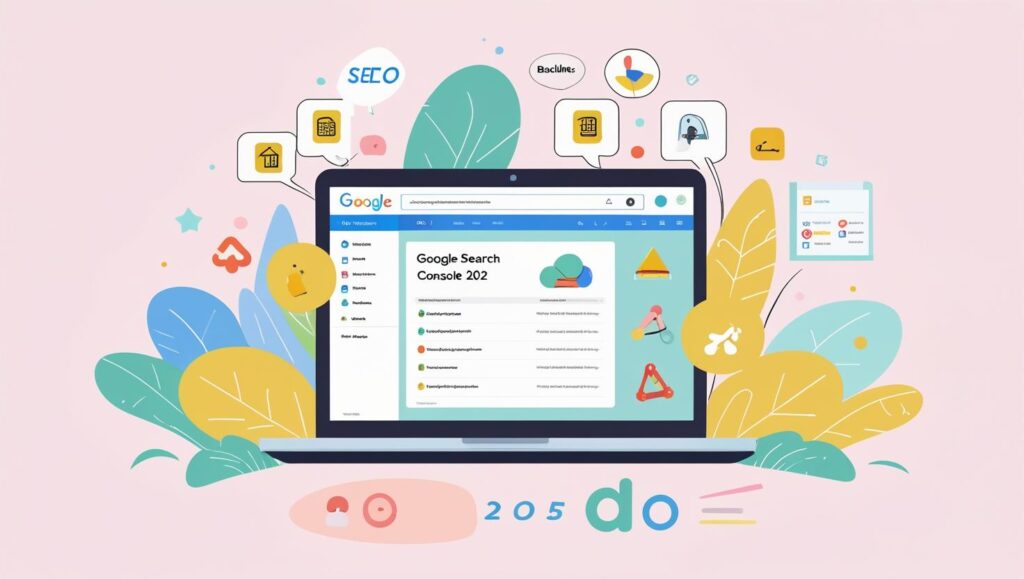Google Search Console tutorial If you’re just starting with SEO, Google Search Console (GSC) is one of the most powerful free tools you can use. It gives you direct insights from Google about how your site is performing in search, what errors need fixing, and what keywords bring you traffic.
Google Search Console tutorial In this complete beginner’s tutorial, you’ll learn how to set up Google Search Console, explore its core features, and use it to grow your traffic in 2025.

What is Google Search Console tutorial?
Google Search Console is a free tool provided by Google that helps website owners monitor, maintain, and troubleshoot their site’s presence in Google Search results.
Why use it?
- See which keywords drive traffic
- Identify and fix technical issues
- Submit sitemaps and request indexing
- Monitor backlinks
- Analyze mobile usability
- Track Core Web Vitals
How to Set Up Google Search Console tutorial
Step 1: Visit Google Search Console
Go to: https://search.google.com/search-console/
Step 2: Choose Your Property Type
You have two options:
- Domain Property – Tracks all data across subdomains (recommended)
- URL Prefix – Tracks data only for a specific URL prefix
Step 3: Verify Your Site
Google gives several options:
- DNS verification (preferred for domain property)
- HTML file upload
- HTML meta tag
- Google Analytics or Tag Manager
Once verified, GSC will start collecting data (it may take a few hours to populate).
Understanding the Google Search Console Dashboard
Google Search Console tutorial Once your property is verified, here are the core features you’ll see:
1. Overview Tab
Gives you a summary of:
- Search performance
- Coverage (indexing issues)
- Experience metrics (Core Web Vitals)
- Enhancements like mobile usability or structured data
Search Performance: Unlocking Keyword Data
This is one of the most valuable features of GSC.
Go to: Performance > Search Results
Key Metrics:
- Total Clicks: How many clicks from search results
- Total Impressions: How many times your site appeared
- Average CTR: Click-through rate
- Average Position: Ranking position for queries
What You Can Do:
✅ See what keywords bring you traffic
✅ Filter data by device, country, page, or date
✅ Discover low-CTR but high-impression keywords for optimization
✅ Track position changes after content updates
URL Inspection Tool
Google Search Console tutorial This tool helps you understand how Google sees a specific page.
What It Shows:
- Whether the page is indexed
- Last crawl date
- Mobile usability status
- Enhancements (breadcrumbs, FAQs, etc.)
Bonus: You can request indexing for new or updated content.
Use case: After publishing a blog, inspect the URL and click “Request Indexing” to speed up its appearance in Google search.

Coverage Report: Fix Indexing Issues
This report shows which pages are:
- Valid (Indexed)
- Error (Not indexed due to issues)
- Excluded (Intentionally or by mistake)
- Valid with warning
Common Errors:
- Submitted URL not found (404)
- Redirect errors
- Soft 404s
- Server (5xx) errors
Fix the issues and click “Validate Fix” to prompt Google to recrawl.
Sitemaps Submission
Submitting your sitemap helps Google discover all your site pages efficiently.
Go to: Index > Sitemaps
How to Submit:
- Add the sitemap URL (e.g.,
https://yourdomain.com/sitemap.xml) - Submit and monitor its status
Pro Tip:
If you’re using WordPress, plugins like Rank Math or Yoast SEO generate sitemaps automatically.
Google Search Console tutorial Mobile Usability Report
With mobile-first indexing, mobile usability is essential.
Go to: Experience > Mobile Usability
You’ll see issues like:
- Text too small to read
- Clickable elements too close
- Content wider than screen
Fix these issues in your site’s CSS or responsive design setup.
Core Web Vitals & Page Experience
Page Experience includes:
- Largest Contentful Paint (LCP)
- First Input Delay (FID)
- Cumulative Layout Shift (CLS)
These are part of Google’s ranking signals since 2021 and still matter in 2025.
Check reports under: Experience > Core Web Vitals
Improve by:
- Optimizing images
- Using proper caching and CDNs
- Removing layout shifts

Links Report: Analyze Backlinks
Google Search Console tutorial Backlinks still matter in SEO, and this report shows:
- Top linked pages
- Top linking sites
- Top linking anchor text
- Internal links
Use this report to:
- Identify toxic backlinks
- Build more internal links to key pages
- Monitor backlinks from PR or guest post campaigns
Enhancements: Structured Data Monitoring
GSC also shows errors in structured data:
- Breadcrumbs
- FAQs
- Reviews
- Products
If you’re using schema markup, GSC tells you:
- Which pages use which schema types
- If there are validation errors
- Suggestions for fixing them
Manual Actions & Security Issues
These sections alert you if:
- Your site is penalized
- You have spammy or hacked content
- There are malware or phishing attempts
If you get a manual action, you must fix the issue and submit a reconsideration request Google Search Console tutorial.
Reports You Should Monitor Weekly
| Report | Why It’s Important |
|---|---|
| Performance | Track keyword and traffic trends |
| Coverage | Catch indexing issues quickly |
| Mobile Usability | Ensure mobile-friendly experience |
| Core Web Vitals | Improve page performance |
| Sitemaps | Confirm Google is crawling your site |
| Links | Watch backlink growth |
Pro Tips for Beginners
- Link GSC with Google Analytics – Gain richer insights.
- Track keyword performance after updates – Monitor CTR and rankings.
- Filter by mobile vs desktop – Optimize for different devices.
- Monitor new errors weekly – Set alerts or reminders.
- Use GSC data for content strategy – Target keywords with high impressions but low clicks.
Google Search Console vs Other SEO Tools
| Feature | Google Search Console | Paid Tools (Ahrefs, SEMrush) |
|---|---|---|
| Keyword Clicks | Yes | Yes |
| Backlink Analysis | Basic | In-depth |
| Indexing Control | Yes | No |
| Crawl Errors | Yes | Limited |
| Cost | Free | Paid |
GSC is essential, even if you use paid tools—it gives data straight from Google.
Frequently Asked Questions
Q1: Is Google Search Console free?
Yes, 100% free.
Q2: How often should I check GSC?
At least once a week, or more if you’re actively updating your site.
Q3: Can I see what people search to find my site?
Yes! Go to Performance > Queries for keyword data.
Q4: How do I add multiple sites to GSC?
Click on the dropdown > Add Property > Repeat setup steps.
Final Thoughts
Google Search Console tutorial Whether you’re a blogger, marketer, or business owner, Google Search Console is a must-use tool in your SEO arsenal. It’s free, powerful, and gives you direct insight from Google—something no other tool can offer.
Mastering the basics in this tutorial will put you ahead of many website owners still guessing how Google views their site Google Search Console tutorial.
